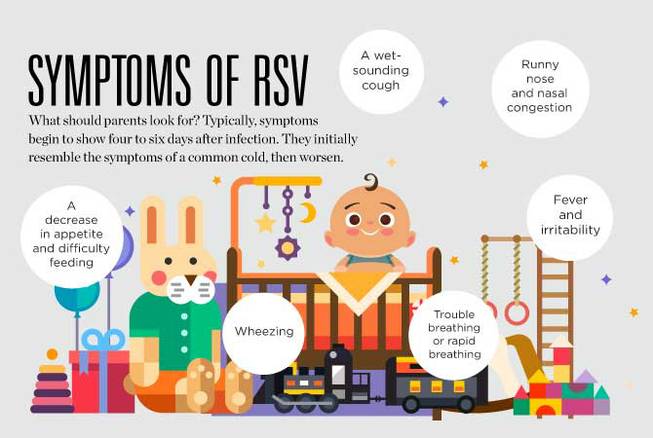
Sunday, Jan. 24, 2016 | 2 a.m.
Most parents don’t consider illness a milestone. But 97 percent of all children contract RSV (Respiratory Syncytial Virus) by their second birthday, and two-thirds of all infants contract the virus by their first birthday.
“It’s extremely common and can lead to serious problems. RSV results in 100,000 infants being hospitalized annually and 500 infant deaths per year in the United States,” said Dr. Craig Nakamura, M.D., of Children’s Lung Specialists and Sunrise Children’s Hospital.
Because RSV has such a high incidence rate, all parents or caretakers of infants should know the symptoms and how to help prevent the virus from being spread.
What is RSV?
RSV can cause upper respiratory infections such as the common cold as well as lower respiratory tract infections such as bronchiolitis and pneumonia. RSV is the most common cause of lower respiratory infections in infants. Most infants who must be hospitalized because of RSV are younger than 6 months.
Who’s at risk?
People can get RSV at any age, but it typically is much less problematic in adults. Adults may even carry and spread the virus unknowingly. RSV typically causes the most complications for infants, premature babies, infants with congenital heart disease or chronic lung disease and infants with compromised immune systems.
“Its impact is seen worldwide, typically during the winter months, the season often lasting from November to April for us,” Nakamura said.
Symptoms
What should parents look for? Typically, symptoms begin to show four to six days after infection. They initially resemble the symptoms of a common cold, then worsen.
“As the virus spreads within the body, the infection can extend to the breathing tubes of the lower respiratory tract, which can cause bronchitis or pneumonia, making it difficult for the child to breathe,” Nakamura said.
Nakamura warned that patients may experience an ear infection at the same time.
If the child has difficulty breathing, turns blue or has a very high fever, take him or her to the hospital immediately. For mild symptoms, call your pediatrician for guidance and monitor the child closely for changes or worsening symptoms.
Other symptoms include:
• A decrease in appetite and difficulty feeding
• A wet-sounding cough
• Trouble breathing or rapid breathing
• Runny nose and nasal congestion
• Fever and irritability
• Wheezing
How is RSV treated?
There is no sure-fire cure for this virus, but doctors may treat the symptoms caused by it.
“Treatments are largely supportive,” Nakamura said. “We make sure the patient does not get dehydrated, possibly give them breathing treatments, and sometimes oxygen is given to keep oxygen levels in the normal range.”
When it comes to viral infections, prevention is the most important medicine.
In some instances, a vaccine-like drug for RSV may be administered, but it’s used exclusively for infants who are considered high-risk. The drug can help prevent the development of severe RSV, but it is not a cure for infants who already have severe RSV.
Preventing the spread of RSV
RSV most often is spread by contact. Many adults with a common cold may spread RSV without realizing it.
“Say you’re at the grocery store, and someone who’s infected just covered their month with their hands after coughing or sneezing and then touches the pull handle at the freezer,” Nakamura said. “A couple of minutes later, an unsuspecting mother comes along and touches the same handle before picking up her crying infant and wiping away his tears. As simple as that, the infant has been exposed.”
Nakamura advises that all parents of infants wash their hands regularly throughout the day and sanitize shared spaces such as doorknobs, countertops and toys to prevent spreading RSV. This is especially important in winter when RSV is most common.
Note: It’s important to remember that RSV can remain viable for 20 minutes on skin, two hours on gloves, seven hours on countertops and eight hours on a stethoscope.

Join the Discussion:
Check this out for a full explanation of our conversion to the LiveFyre commenting system and instructions on how to sign up for an account.
Full comments policy